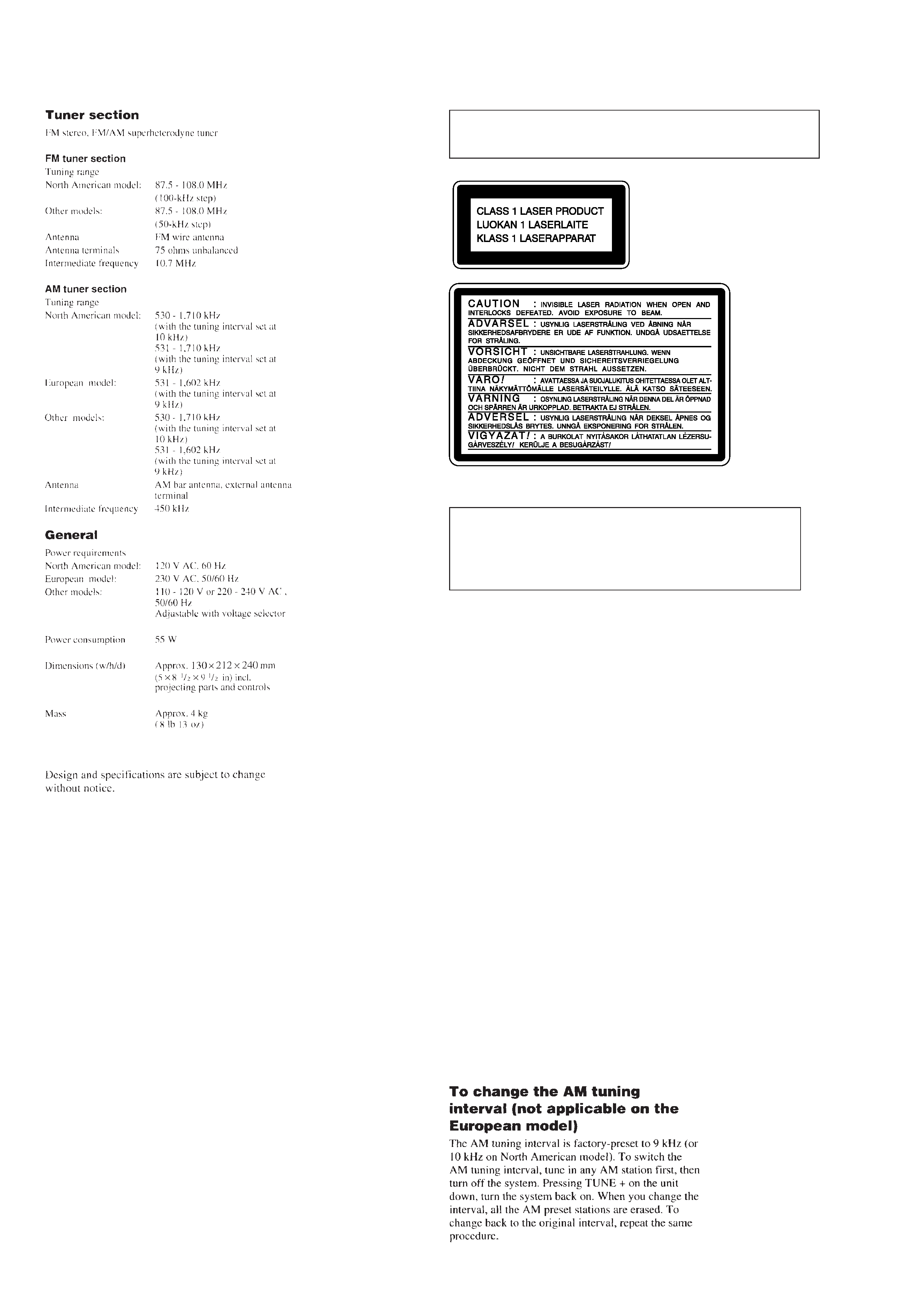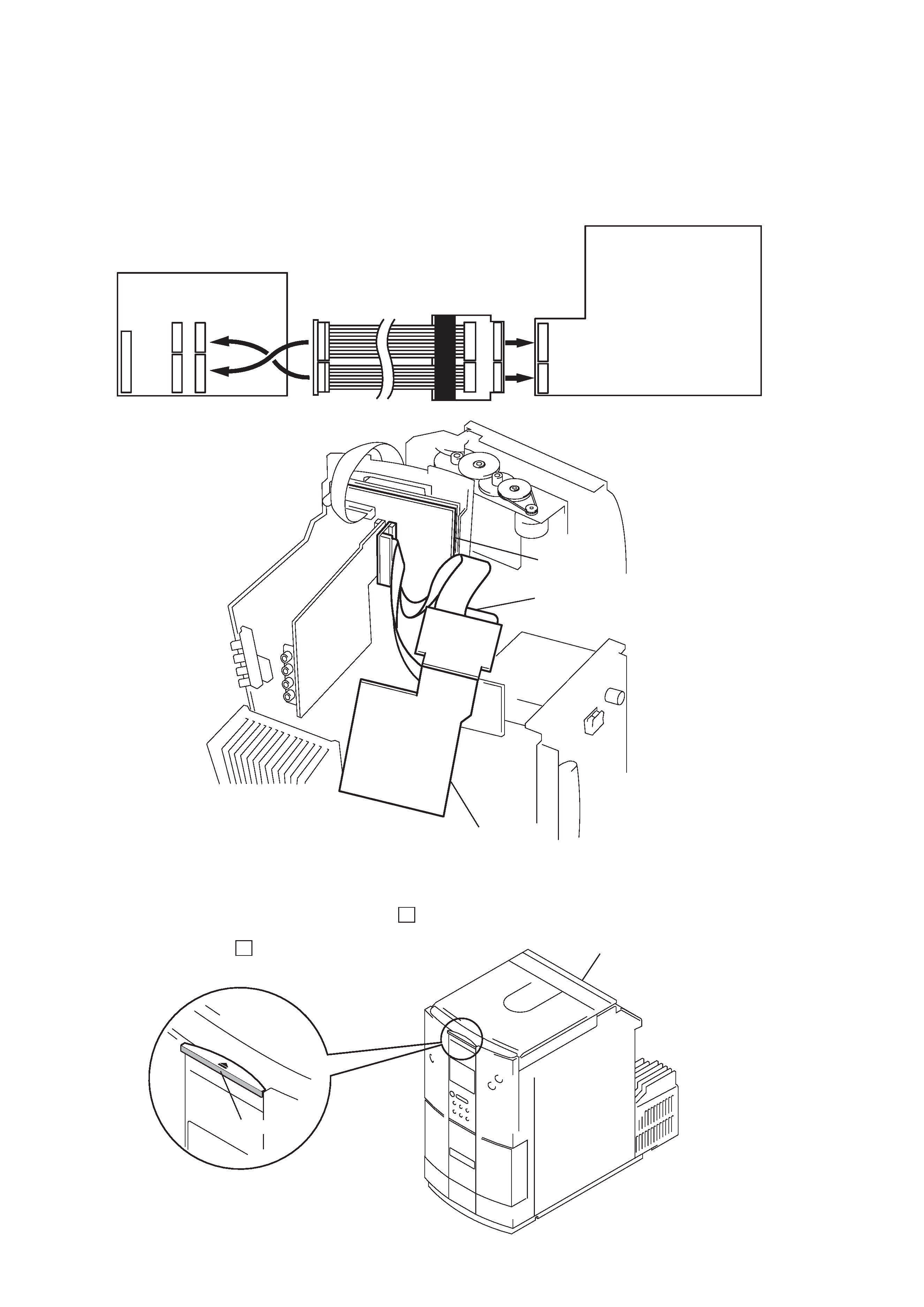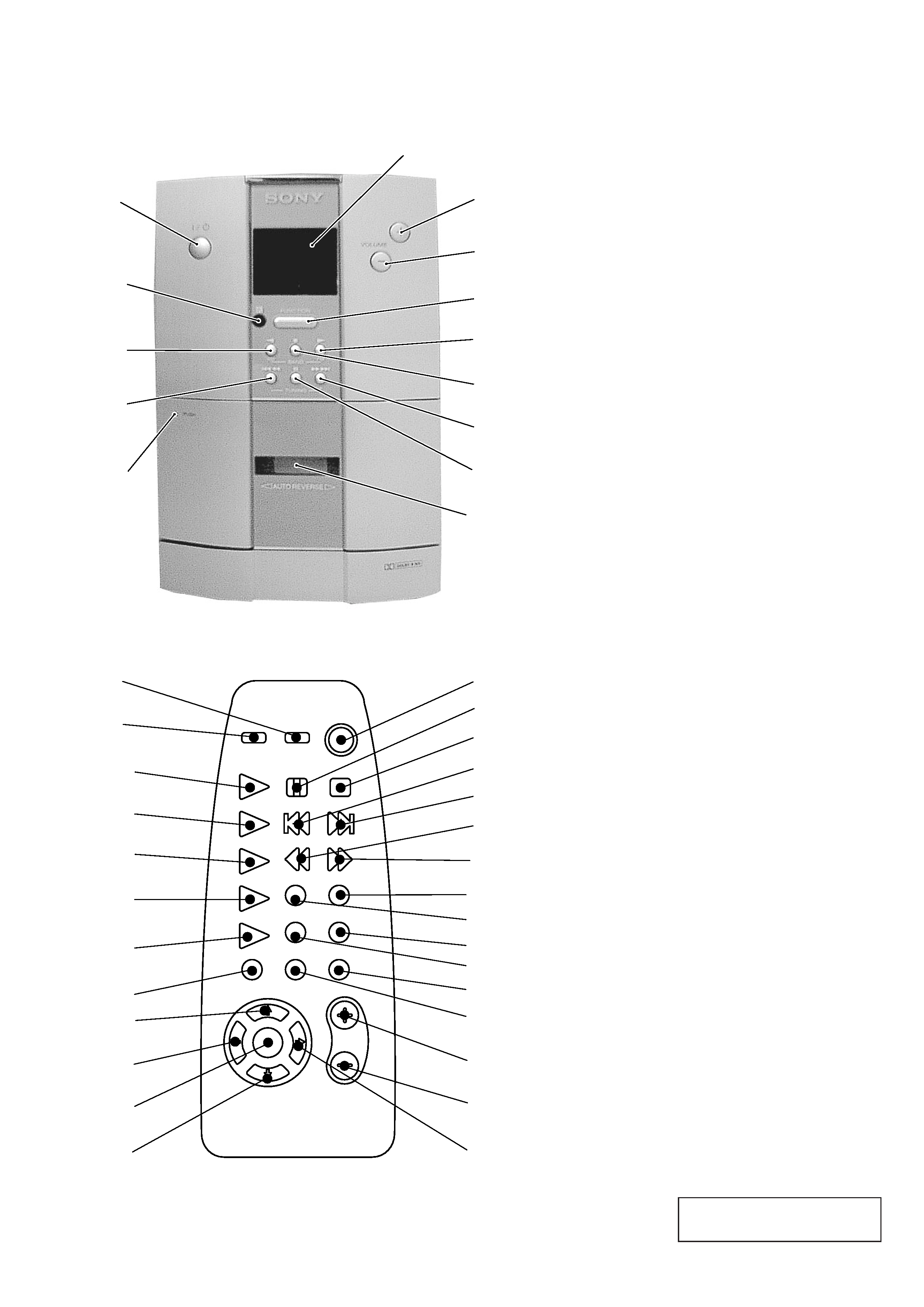
1
HCD-ED2
US Model
Canadian Model
AEP Model
UK Model
E Model
Australian Model
SPECIFICATIONS
COMPACT DISC DECK RECEIVER
-- Continued on next page --
Model Name Using Similar Mechanism NEW
Mechanism Type
CDM-61
Base Unit Type
KSM-331AAN/K1NP
Optical Pick-up Type
KSS-331A (RP)
Model Name Using Similar Mechanism NEW
Tape Transport Mechanism Type
CMAL1Z025A
CD
SECTION
TAPE DECK
SECTION
SERVICE MANUAL
HCD-ED2 is the tuner, deck, CD and
amplifier section in CMT-ED2.
Ver 1.2 2004.05
With CORRECTION-1R
(9-929-025-92)
9-929-025-13
2004E02-1
© 2004.05
Sony Corporation
Home Audio Company
Published by Sony Engineering Corporation
This systems is equipped with the Dolby* B-type noise
reduction system.
*Dolby noise reduction manufactured under license
from Dolby Laboratories Licensing Corporation.
"DOLBY" and the double-D symbol
a are
trademarks of Dolby Laboratories Licensing
Corporation.
Amplifier section
For the U.S. model
AUDIO POWER SPECIFICATIONS
POWER OUTPUT AND TOTAL HARMONIC
DISTORTION:
With 8-ohm loads both channels driven from
90 - 15,000 Hz; rated 15 watts per channel
minimum RMS power with no more than 09.%
total harmonic distortion from 250 milliwatts to
rated output.
North American model:
Continuous RMS power output (reference):
17 + 17 W
(8 ohms at 1 kHz, 10%THD)
European model:
DIN power output (rated):
15 + 15 W
(8 ohms at 1 kHz, DIN)
Continuous RMS power output (reference):
17 + 17 W
(8 ohms at 1 kHz, 10% THD)
Music power output (reference):
35 + 35 W
Other models:
The following measured at 230 V AC, 60 Hz
DIN power output (rated):
15 + 15 W
(8 ohms at 1 kHz, DIN)
Continuous RMS power output (reference):
17 + 17 W
(8 ohms at 1 kHz, 10%THD)
Inputs
MD IN (phono jacks) :
Sensitivity 1,000 mV, impedance
47 kilohm
CD DIGITAL OUT OPTICAL:
optical
PHONES (stereo phone jack):
Accepts headphones with an
impedance of 8 ohms or more
SPEAKER:
Accepts Impedance of 8 to 16
ohms
CD player section
System
Compact disc and digital
audio
system
Laser
Semiconductor laser
(
= 780 nm)
Emission duration: continuous
Laser output
MAX 44.6
µW*
*This output is the value
measured at a distance of
200 mm from the
objective
lens surface on
the Optical
Pick-up Block
with 7 mm
aperture.
Wavelength
780 - 790 nm
Frequency response
2 Hz - 20 kHz (
±0.5 dB)
Tape player section
Recording system 4-track 2-channel stereo
Frequency response (DOLBY NR OFF)
50 - 13,000 Hz (
±3 dB),
using a Sony TYPE I cassette
50 - 14,000 Hz (
±3 dB),
using a Sony TYPE II cassette

2
SAFETY-RELATED COMPONENT WARNING !!
COMPONENTS IDENTIFIED BY MARK
! OR DOTTED LINE
WITH MARK
! ON THE SCHEMATIC DIAGRAMS AND IN
THE PARTS LIST ARE CRITICAL TO SAFE OPERATION.
REPLACE THESE COMPONENTS WITH SONY PARTS
WHOSE PART NUMBERS APPEAR AS SHOWN IN THIS
MANUAL OR IN SUPPLEMENTS PUBLISHED BY SONY.
CAUTION
Use of controls or adjustments or performance of procedures
other than those specified herein may result in hazardous ra-
diation exposure.
Notes on chip component replacement
· Never reuse a disconnected chip component.
· Notice that the minus side of a tantalum capacitor may be
damaged by heat.
Flexible Circuit Board Repairing
· Keep the temperature of soldering iron around 270°C
during repairing.
· Do not touch the soldering iron on the same conductor of the
circuit board (within 3 times).
· Be careful not to apply force on the conductor when soldering
or unsoldering.
Laser component in this product is capable of emitting radiation
exceeding the limit for Class 1.
This appliance is classified as
a CLASS 1 LASER product.
The CLASS 1 LASER PROD-
UCT MARKING is located on
the rear exterior.
This caution
label is located
inside the unit.
ATTENTION AU COMPOSANT AYANT RAPPORT
À LA SÉCURITÉ!!
LES COMPOSANTS IDENTIFIÉS PAR UNE MARQUE
!SUR
LES DIAGRAMMES SCHÉMATIQUES ET LA LISTE DES
PIÈCES SONT CRITIQUES POUR LA SÉCURITÉ DE
FONCTIONNEMENT. NE REMPLACER CES COMPOSANTS
QUE PAR DES PIÈCES SONY DONT LES NUMÉROS
SONT DONNÉS DANS CE MANUEL OU DANS LES
SUPPLÉMENTS PUBLIÉS PAR SONY.

3
NOTES ON HANDLING THE OPTICAL PICK-UP BLOCK
OR BASE UNIT
The laser diode in the optical pick-up block may suffer electrostatic
break-down because of the potential difference generated by the
charged electrostatic load, etc. on clothing and the human body.
During repair, pay attention to electrostatic break-down and also
use the procedure in the printed matter which is included in the
repair parts.
The flexible board is easily damaged and should be handled with
care.
NOTES ON LASER DIODE EMISSION CHECK
The laser beam on this model is concentrated so as to be focused on
the disc reflective surface by the objective lens in the optical pick-
up block. Therefore, when checking the laser diode emission, ob-
serve from more than 30 cm away from the objective lens.
LASER DIODE AND FOCUS SEARCH OPERATION
CHECK
Carry out the "S curve check" in "CD section adjustment" and check
that the S curve waveform is output several times.
SAFETY CHECK-OUT
After correcting the original service problem, perform the follow-
ing safety checks before releasing the set to the customer:
Check the antenna terminals, metal trim, "metallized" knobs, screws,
and all other exposed metal parts for AC leakage. Check leakage as
described below.
LEAKAGE
The AC leakage from any exposed metal part to earth Ground and
from all exposed metal parts to any exposed metal part having a
return to chassis, must not exceed 0.5 mA (500 microampers). Leak-
age current can be measured by any one of three methods.
1. A commercial leakage tester, such as the Simpson 229 or RCA
WT-540A. Follow the manufacturers' instructions to use these
instruments.
2. A battery-operated AC milliammeter. The Data Precision 245
digital multimeter is suitable for this job.
3. Measuring the voltage drop across a resistor by means of a VOM
or battery-operated AC voltmeter. The "limit" indication is 0.75
V, so analog meters must have an accurate low-voltage scale.
The Simpson 250 and Sanwa SH-63Trd are examples of a pas-
sive VOM that is suitable. Nearly all battery operated digital
multimeters that have a 2V AC range are suitable. (See Fig. A)
Fig. A. Using an AC voltmeter to check AC leakage.
0.15
µF
To Exposed Metal
Parts on Set
1.5k
AC
voltmeter
(0.75V)
Earth Ground
1. SERVICING NOTE .......................................................... 4
2. GENERAL .......................................................................... 5
3. DISASSEMBLY
3-1. CD Base and Base Unit .......................................................... 7
3-2. Rear Panel ............................................................................. 7
3-3. Bottom Cover and Front Panel Block ................................... 8
3-4. Door Cover assy and Mechanical Deck (Cassette) ............... 8
4. MECHANICAL ADJUSTMENTS ................................ 9
5. ELECTRICAL ADJUSTMENTS ................................. 9
6. DIAGRAMS
6-1. Circuit Boards Location ...................................................... 13
6-2. Schematic Diagram BD Section ................................... 14
6-3. Printed Wiring Board BD Section ................................. 15
6-4. Schematic Diagram Function Section ........................... 16
6-5. Printed Wiring Board Function Section ........................ 17
6-6. Schematic Diagram Tape Preamp Section .................... 18
6-7. Printed Wiring Board Tape Preamp Section ................. 19
6-8. Schematic Diagram Display Section ............................. 20
6-9. Printed Wiring Board Display Section .......................... 21
6-10. Schematic Diagram Relay Section ............................. 22
6-11. Printed Wiring Board Relay Section .......................... 23
6-12. Schematic Diagram Power Section ............................ 24
6-13. Printed Wiring Board Power Section ......................... 25
6-14. Schematic Diagram RDS Section ............................... 26
6-15. Printed Wiring Board RDS Section ............................ 27
6-16. IC Block Diagrams ........................................................... 28
6-17. IC Pin Functions ............................................................... 30
7. EXPLODED VIEWS
7-1. CD Section .......................................................................... 33
7-2. Rear Panel Section .............................................................. 34
7-3. Front Panel Section ............................................................. 35
7-4. Mechanism Deck Section (Cassette) .................................. 36
7-5. Base Unit Section ................................................................ 37
8. ELECTRICAL PARTS LIST ........................................ 38
TABLE OF CONTENTS

4
W703-1
W703-2
Touch sensor
The hinge may be damaged.
M703-2
M703-1
Relay board
Relay board
Tape preamp board
Extension cable (23pin)(25cmm)
Extension cable (23pin)(25cmm)
(CMT-ED2, J-2501-179-A)
J-2501-179-A
Tape preamp board
CMT
-ED2
SECTION 1
SERVICING NOTE
Connectiong the extension cable (CMT-ED2)
CD LID
The CD lid of this unit is opened and closed electrically.
Opening or closing the CD lid with force when the power plug is
not connected to the outlet or the power is OFF may damage the
hinge.
When servicing the unit, open and close the lid by touch the
§
button. (metal side)
The lid does not move even if the
§ is touched.
Touch the metal part of the front panel.

5
LOCATION OF PARTS AND CONTROLS
1
1/u (Power) switch
2
Display window
3
VOLUME + button
4
VOLUME - button
5
FUNCTION
6
( button
7
p (stop) button
8
) + + button
9
P button
10 DECK Lid
11
6 Push
12
= 0 - button
13
9 button
14 Remote sensor
SECTION 2
GENERAL
Front Panel
6
2
1
28
27
26
25
24
23
3
4
5
7
8
10
11
12
13
16
9
14
15
17
22
21
20
19
18
REMOTE
1
OPEN/CLOSE button
2
DISPLAY button
3
1/u (power) switch
4
(pause) button
5
(stop) button
6
(AMS*) TUNING - button
7
± (AMS*) TUNING + button
8
º button
9
, button
10
r REC button
11 DOLBY NR button
12 SURROUND button
13 TUNING MODE button
14 DSG button
15 STEREO/MONO button
16 VOLUME + button
17 VOLUME - button
18 TIMER SELECT button
19 SLEEP button
20 ENTER button
21 TIMER SET button
22 MEMORY button
23 CD REPEAT button
24 PLAY MODE button
25 DIR MODE button
26 TAPE
oe button
27 TUNER/BAND button
28 CD
· button
* AMS is the abbreviation for Automatic Music Sensor.
1
2
3
11
12
13
4
5
14
6
7
9
8
10
This section is extracted from
instruction manual.
